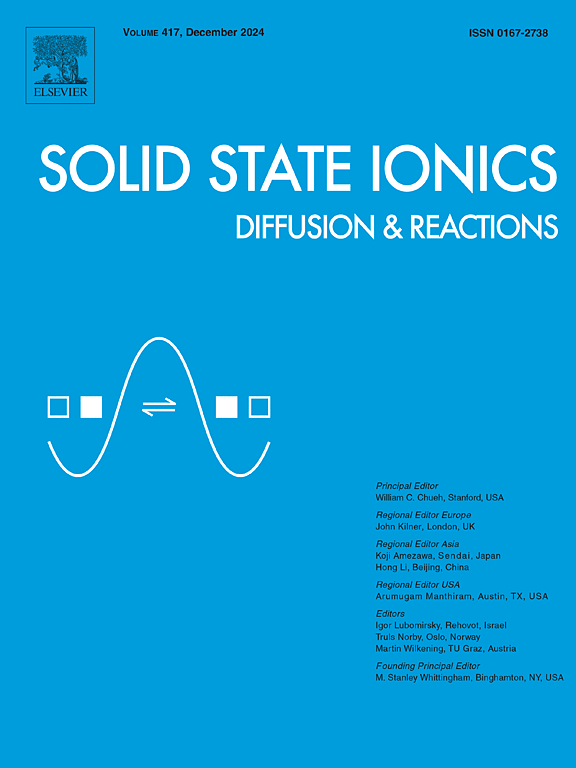锂离子电池正极 LiNixCoyMn1-x-yO2 作为质子陶瓷燃料电池空气电极的综合研究
IF 3
4区 材料科学
Q3 CHEMISTRY, PHYSICAL
引用次数: 0
摘要
质子陶瓷燃料电池(PCFC)在低温条件下具有显著的高能量转换效率和巨大的应用潜力。在此背景下,我们探索了层状三元锂离子电池(LIB)材料 LiNixCoyMn1-x-yO2(LNCM)作为 PCFCs 潜在阴极的可能性。利用密度泛函理论(DFT)计算,我们对氧空位、水合能、状态密度和其他相关特性进行了全面分析,以评估这些三元材料。理论和实验结果都表明,LiNi0.5Co0.2Mn0.3O2(LNCM523)作为 PCFCs 阴极可能具有最佳性能。值得注意的是,在 700 °C 的空气中煅烧 100 小时后,LNCM523 没有出现相变或新相的出现。在 BaZr0.1Ce0.7Y0.1Yb0.1O3-δ (BZCYYb) 电解质上测量的 LNCM523 阻抗在 650 °C 时为 0.225 Ω cm2。在此温度下,单电池的峰值功率密度达到 355 mW cm-2。此外,在 550 °C 下进行的 100 小时稳定性测试中,单电池的输出性能保持不变。在电解模式下,温度为 650 ℃、电压为 1.3 V 时,电解水的电流密度达到 1.75 A cm-2。基于这些良好的结果,LNCM 成为 PCFCs 的一种可行的阴极候选材料。本文章由计算机程序翻译,如有差异,请以英文原文为准。
Comprehensive study on lithium-ion battery cathode LiNixCoyMn1-x-yO2 as an air electrode for protonic ceramic fuel cells
The protonic ceramic fuel cells (PCFCs) exhibits a remarkable high-energy conversion efficiency and significant application potential at low temperatures. In this context, the layered ternary lithium-ion batteries (LIB) material, LiNixCoyMn1-x-yO2 (LNCM), is explored as a potential cathode for PCFCs. Utilizing density functional theory (DFT) calculations, we have conducted a comprehensive analysis of oxygen vacancies, hydration energy, density of states, and other pertinent properties to evaluate these ternary materials. Both theoretical and experimental findings suggest that LiNi0.5Co0.2Mn0.3O2 (LNCM523) may offer the optimal performance as a PCFCs cathode. Notably, after calcination in air at 700 °C for 100 h, LNCM523 displayed no phase transition or the emergence of new phases. The impedance of LNCM523, measured on a BaZr0.1Ce0.7Y0.1Yb0.1O3-δ (BZCYYb) electrolyte, is 0.225 Ω cm2 at 650 °C. At this temperature, the peak power density of the single cell reaches 355 mW cm−2. Moreover, during a 100-h stability test conducted at 550 °C, the output performance of the single cell remained unaltered. In electrolysis mode, at 650 °C and 1.3 V, the current density for electrolysis water attained 1.75 A cm−2. Based on these promising results, LNCM emerges as a viable cathode candidate for PCFCs.
求助全文
通过发布文献求助,成功后即可免费获取论文全文。
去求助
来源期刊

Solid State Ionics
物理-物理:凝聚态物理
CiteScore
6.10
自引率
3.10%
发文量
152
审稿时长
58 days
期刊介绍:
This interdisciplinary journal is devoted to the physics, chemistry and materials science of diffusion, mass transport, and reactivity of solids. The major part of each issue is devoted to articles on:
(i) physics and chemistry of defects in solids;
(ii) reactions in and on solids, e.g. intercalation, corrosion, oxidation, sintering;
(iii) ion transport measurements, mechanisms and theory;
(iv) solid state electrochemistry;
(v) ionically-electronically mixed conducting solids.
Related technological applications are also included, provided their characteristics are interpreted in terms of the basic solid state properties.
Review papers and relevant symposium proceedings are welcome.
 求助内容:
求助内容: 应助结果提醒方式:
应助结果提醒方式:


